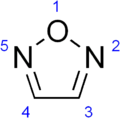 | |||
| |||
| Names | |||
|---|---|---|---|
| Preferred IUPAC name 1,2,5-Oxadiazole | |||
| Identifiers | |||
3D model (JSmol) | |||
| ChemSpider | |||
PubChem CID | |||
| UNII | |||
CompTox Dashboard (EPA) | |||
| |||
| |||
| Properties | |||
| C2H2N2O | |||
| Molar mass | 70.05008 g/mol | ||
| Appearance | clear oil | ||
| Density | 1.168 g/cm3 [1] | ||
| Melting point | −28 °C (−18 °F; 245 K) [1] | ||
| Boiling point | 98 °C (208 °F; 371 K) [1] | ||
Except where otherwise noted, data are given for materials in their standard state (at 25 °C [77 °F], 100 kPa). | |||
Furazan, or 1,2,5-oxadiazole, is a heterocyclic aromatic organic compound consisting of a five-atom ring containing 1 oxygen and 2 nitrogen atoms. The furazan ring system is also found in the steroid furazabol. Furazan and its derivatives are obtained from the oxime derivatives of 1,2-diketones.

